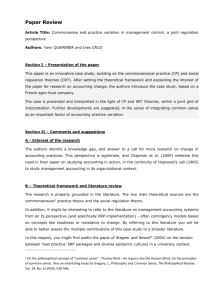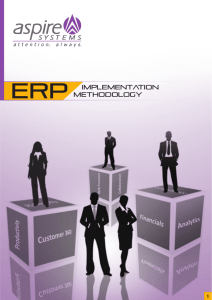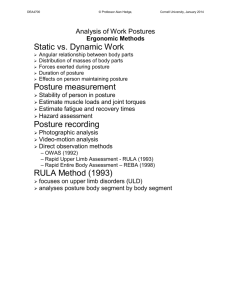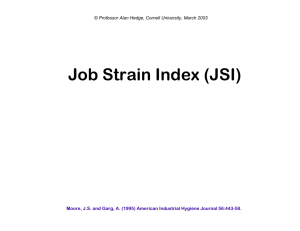Overall resource effectiveness, cycle time reduction & capacity
advertisement
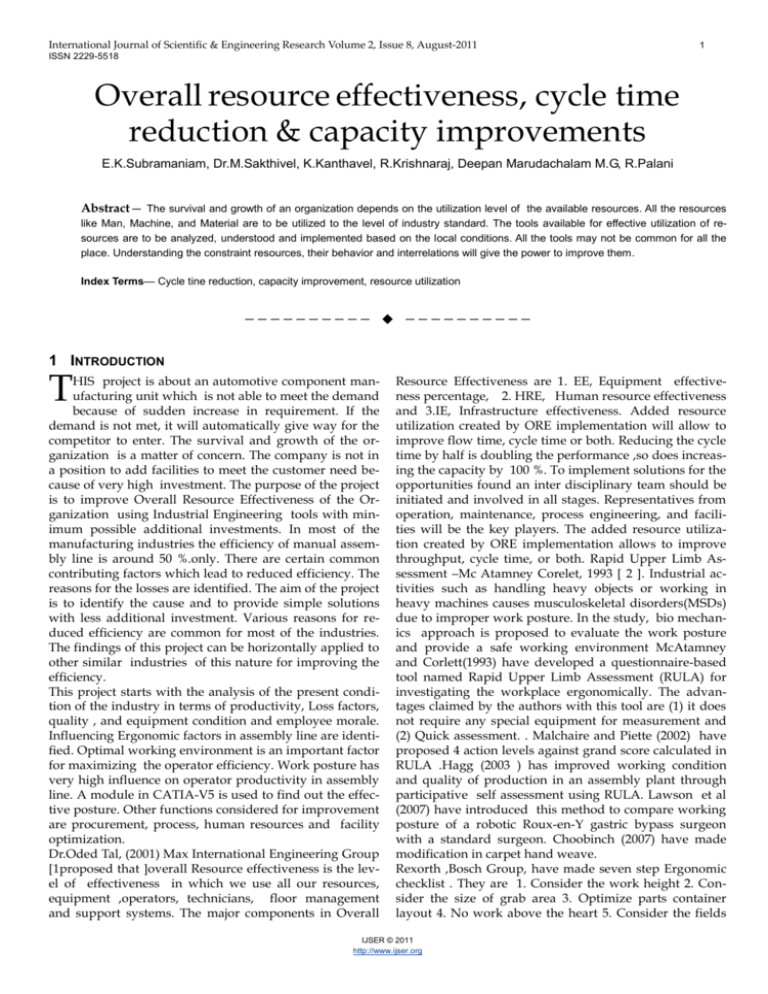
International Journal of Scientific & Engineering Research Volume 2, Issue 8, August-2011 1 ISSN 2229-5518 Overall resource effectiveness, cycle time reduction & capacity improvements E.K.Subramaniam, Dr.M.Sakthivel, K.Kanthavel, R.Krishnaraj, Deepan Marudachalam M.G, R.Palani Abstract— The survival and growth of an organization depends on the utilization level of the available resources. All the resources like Man, Machine, and Material are to be utilized to the level of industry standard. The tools available for effective utilization of resources are to be analyzed, understood and implemented based on the local conditions. All the tools may not be common for all the place. Understanding the constraint resources, their behavior and interrelations will give the power to improve them. Index Terms— Cycle tine reduction, capacity improvement, resource utilization —————————— —————————— 1 INTRODUCTION T HIS project is about an automotive component manufacturing unit which is not able to meet the demand because of sudden increase in requirement. If the demand is not met, it will automatically give way for the competitor to enter. The survival and growth of the organization is a matter of concern. The company is not in a position to add facilities to meet the customer need because of very high investment. The purpose of the project is to improve Overall Resource Effectiveness of the Organization using Industrial Engineering tools with minimum possible additional investments. In most of the manufacturing industries the efficiency of manual assembly line is around 50 %.only. There are certain common contributing factors which lead to reduced efficiency. The reasons for the losses are identified. The aim of the project is to identify the cause and to provide simple solutions with less additional investment. Various reasons for reduced efficiency are common for most of the industries. The findings of this project can be horizontally applied to other similar industries of this nature for improving the efficiency. This project starts with the analysis of the present condition of the industry in terms of productivity, Loss factors, quality , and equipment condition and employee morale. Influencing Ergonomic factors in assembly line are identified. Optimal working environment is an important factor for maximizing the operator efficiency. Work posture has very high influence on operator productivity in assembly line. A module in CATIA-V5 is used to find out the effective posture. Other functions considered for improvement are procurement, process, human resources and facility optimization. Dr.Oded Tal, (2001) Max International Engineering Group [1proposed that ]overall Resource effectiveness is the level of effectiveness in which we use all our resources, equipment ,operators, technicians, floor management and support systems. The major components in Overall Resource Effectiveness are 1. EE, Equipment effectiveness percentage, 2. HRE, Human resource effectiveness and 3.IE, Infrastructure effectiveness. Added resource utilization created by ORE implementation will allow to improve flow time, cycle time or both. Reducing the cycle time by half is doubling the performance ,so does increasing the capacity by 100 %. To implement solutions for the opportunities found an inter disciplinary team should be initiated and involved in all stages. Representatives from operation, maintenance, process engineering, and facilities will be the key players. The added resource utilization created by ORE implementation allows to improve throughput, cycle time, or both. Rapid Upper Limb Assessment –Mc Atamney Corelet, 1993 [ 2 ]. Industrial activities such as handling heavy objects or working in heavy machines causes musculoskeletal disorders(MSDs) due to improper work posture. In the study, bio mechanics approach is proposed to evaluate the work posture and provide a safe working environment McAtamney and Corlett(1993) have developed a questionnaire-based tool named Rapid Upper Limb Assessment (RULA) for investigating the workplace ergonomically. The advantages claimed by the authors with this tool are (1) it does not require any special equipment for measurement and (2) Quick assessment. . Malchaire and Piette (2002) have proposed 4 action levels against grand score calculated in RULA .Hagg (2003 ) has improved working condition and quality of production in an assembly plant through participative self assessment using RULA. Lawson et al (2007) have introduced this method to compare working posture of a robotic Roux-en-Y gastric bypass surgeon with a standard surgeon. Choobinch (2007) have made modification in carpet hand weave. Rexorth ,Bosch Group, have made seven step Ergonomic checklist . They are 1. Consider the work height 2. Consider the size of grab area 3. Optimize parts container layout 4. No work above the heart 5. Consider the fields IJSER © 2011 http://www.ijser.org International Journal of Scientific & Engineering Research Volume 2, Issue 8, August-2011 2 ISSN 2229-5518 of vision 6.Match light intensity to the work task and 7.Properly adjust work equipment to the task. No Cost Applications for assembly cycle time reduction –Steven Brown,Joerg Momarchke and France Leible ,Balanstrasse 73 Munich [3]. The parameters which contribute for cycle time reduction are1.Handler Dedication 2.Rework and Retest 3.Unscheduled Down time 4.Preventive Maintenance 5.Operator Training 6.Operator Staffing 7.Dispatch Rules 8.Hot Lots 9.Changing Process Flow 9.Lot Size 10.Batch Size 11.Lot Release 12.Process Speed Improvements. By applying simulation models and analysis, the back end cycle time can be reduced by 60% while maintaining the current capacity loading time. This paper discusses recommendations for the assembly area. Many aspects and findings and recommendations for the study apply to complex manufacturing sites in general. For example, the cycle time can be reduced by using smaller transport lot sizes. Operation of non-constraint equipment such that material flows smoothly to the constraint equipment. Lower variability in lot releases reduces the cycle time. ERP Implementation and Change Management-Nick Mutt 2010 [4]. Employees are the key players in ERP implementation. The employees of the organization will be in the capacity of process owners, software users and administrators of the ERP software. The main challenge of an ERP implementation is to achieve the acceptability of the systems to the employees and for them to perceive the benefits to the organization and to their way of working. ERP system helps in changing the process; it is designed and developed by adopting best practices of specific industries. During implementation, organization may require to change some business processes to meet the software standards, which are industry specific standards. Business process cannot change without top management support. It is quite necessary to change some of the business process. It helps in implementation. Customization is costly and not good for any ERP project. Little bit customization is ok but too much customization will affect ERP project Detailed literature survey shows there is always a 50 percent scope for productivity improvement in any industry .To achieve this, the problem is to be defined and the productivity tools to be applied in a systematic way. 2. PROBLEM DEFINITION Sudden increase in market demand and the organization is not able to produce the required quantity because of capacity constraints. Capacity Vs Demand is projected in Fig.1. Low productivity in the Assembly line is a matter of concern Fig.1 Capacity Vs Demand 3. OBJECTIVES Increase the Assembly line performance shown in Table 1 Table 1 Present and Proposed Assembly line Performance Performance Measures Unit of Measurement Presen t level Target level seconds 20.5 to 48 20.5 Numbers 920 1400 Cycle Time Production per shift (Ideal conditions ) Production loss per shift Efficiency Improvement % % 15 - 0 80 4. METHODOLOGY Various functions in an organization contribute for the production and delivery of products to the customers in right time. The key functions / areas considered for this study are, 1) Improving Ergonomic Conditions In Assembly Line 2) Productivity Increase Through Line Balancing 3) Layout Optimization 4) Process Improvement 5) Improvement In Procurement 6) Job Scheduling 7) Equipment Reliability Improvement 8) Design / Product Improvement 9) Mprovements In Hr Activities 10) Improvement In Communication Note : Activity 10 is the Preliminary activity in the Assembly line. Other Activities are supporting activities for delivering the right quality and quantity of child parts to the Assembly line. 5. PODUCTIVITY INCREASE BY IMPROVING IJSER © 2011 http://www.ijser.org International Journal of Scientific & Engineering Research Volume 2, Issue 8, August-2011 3 ISSN 2229-5518 ERGONOMIC CONDITIONS IN LINE ASSEMBLY Initial Status of Assembly Line Initial condition of Assembly line recorded after conducting Cycle Time study. Required data were collected and the details are given in the table 2 Table 2 Assembly Cycle Time Study Results ( Study conducted during optimum production hours ) rework ) Rework percentage : 8% Required Horn production per shift considering rework : 1200 X 0.92 : 1100 Nos Present output per shift Op.No 10 20 30 40 50 60 70 80 90 Operation Name Coil Lock, PH & TS Assembly Terminal Base Tightening Diaphragm Assembly & Measurement Gasket selection & pre horn Assembly Side screw Tightening Mounting Bracket Assembly and tightening Horn Tuning and Testing Marking and sealant Application Final Inspection Cycle Time Observed (sec) Operator Rating % Cycle time With rating 25 95 23.8 18.7 80 15 27 90 24 12 90 10.8 19.5 95 18.5 20 80 16 21.5 80 17.2 1. 16 95 15.2 2. 20 90 18 3. Line Efficiency 6. AVERAGE CYCLE TIME STUDY RESULTS ( FINAL STAGE ) Table 3 Average cycle time study Action plans are different for different color codes The level varies from 1 to 5. The action level is 1 for green color and 5 for red color After the corrective actions the RULA score should be less than 2 8. EQUIPMENT RELIABILITY IMPROVEMENT : 158.8 seconds The key areas covered in the project are 1.Reduce MTTR 2.Increase MTBF 3.Preventive Maintenance 4.Predictive Maintenance 5.Maintenance prevention : 158.8 / ( 9 * 24 ) : 73.5 % BALANCE DELAY ) 7. PLANNED RULA SCORE AND ACTION PLANS Note : Allowance included in the cycle time Total Work time in all stations : 920 N0s 8.1 DESIGN / PRODUCT IMPROVEMENT : ( 100 – 73.50 % ) : 26.50 % Number of Horns to be produced per shift : 60 / 24 X 60 X 8 ( as per Time study report ) : 1200 Nos ( including The following are the points to be considered in this project for improving the efficiency 1. Standard parts 2. Liberal tolerances 3.Reduce part counts 4.Combination of parts 5.Standardization of parts 6. Symmetrical parts 7.Self fixturing 8. Easy handling 9.Mistake proof or poka yoke IJSER © 2011 http://www.ijser.org International Journal of Scientific & Engineering Research Volume 2, Issue 8, August-2011 4 ISSN 2229-5518 shift ) Posture improvement ) 8.2 Standardization Standardization of parts helps part suppliers rationalize their product lines and allow them to 3 Reduce their overhead costs and subsidies, which allow them to be more cost competitive. Assembly line Efficiency Balance Delay Operator Fatigue Uniform Production Transportation cost reduction 2 Improve their operational flexibility, resulting in better delivery 4 5 6 Simplify their supply chain management Free valuable resources to improve their operations and quality, implement better product development practices, and introduce new capabilities like build – % 72.5 88.2 % 27.5 11.8 - YES NO - NO YES % - Type of Production - Batc h 8 Machine Loading - - - YES NO - Fair GO OD Fair GO OD This project covers the importance and benefits achieved because of standardization 8.4 IMPROVEMENT IN COMMUNICATION 8. Sl. N o 1 RESULTS AND DISCUSSIONS Details Unit of Measurement Before After Tools Used Assembly output (Horns / Numbers 920 144 0 1. Ergonomics ( Work Line Stoppage for want of parts Delivery Commitment Employee satisfaction 9 10 11 9. Effective, fast and right communication is an important parameter in the supply chain management. With the support of IT, communication system developed for material flow and horizontally deployed to various functions Single piec e flo w Impro ved Ela pse d Tim e 7 to-order &mass 8.3 Improvements In HR Activities Some of the common issues which almost all the industries are facing now are, 1. Manpower shortage 2.Employee involvement 3.Skill level of employees 4.Employee cost 5.Productivity level 6 .Qualification level We could overcome these problems to some extent with the following policy decisions 1. Ensure job security to skilled / deserved operators 2. Counseling 3. Match the salary to Industry standards 4. Training / Job rotation 5. Introduction of incentives 6. Hostel, food and transport facilities for employees 7. Recruitment of female candidates and the introduction of shifts for them 66 2. Line Balancing 3. Layout Planning 4. KANBAN 5. Two Bin System 6.Job Scheduling CONCLUSION Standard Tools like ERP, Ergonomics study, Poka Yoke are available .Either they are not fully understood or not applied due to cost implications or lack of awareness. Some companies increase production but not the productivity. Continuous training and creating good working environment motivates the employees for improved productivity. All the bottleneck areas have been identified and simple solutions provided for the problems .We could achieve the results as per the plan. This methodology can be horizontally deployed to similar industries for improving the overall efficiency REFERENCES IJSER © 2011 http://www.ijser.org International Journal of Scientific & Engineering Research Volume 2, Issue 8, August-2011 ISSN 2229-5518 1 2. 3. 4. 5. 6. 7. 8. 9. 10. Overall Resource Effectiveness ,the key for cycle time reduction & Capacity ImprovementsDr.Oded Tal Rapid Upper Limb Assessment -Mc Atamney Corelet(1993) No Cost Applications for assembly cycle time reduction-Steve Brown, Joerg Momarchke and France Leible ERP Implementation and Change ManagementNick Mutt(2010) Successful Design for Assembly-Dr.Mike Shipulsky(2007) Design for Manufacturing and AssemblyJohnyater An Introduction to Supply Chain ManagementRam Ganeshan &Terry P.Harrison Supply Chain Management Cost ReductionDr.David M.Anderson,P.E.Fasme(2010) Design for Manufacturability-Dr.David M.Anderson(2010) Part Standardization-Dr.David M.AndersonP.E.CMC(2010) IJSER © 2011 http://www.ijser.org 5




